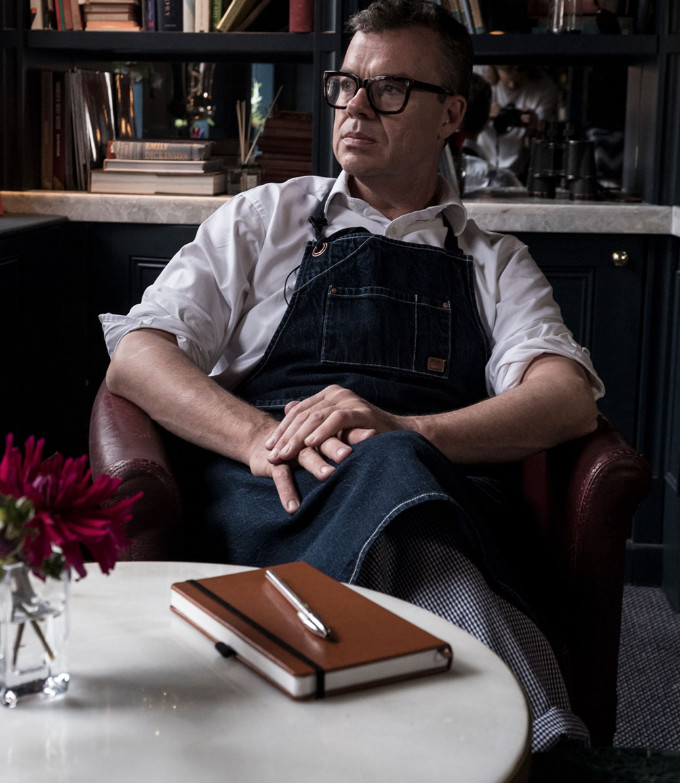What is a dish you grew up with?
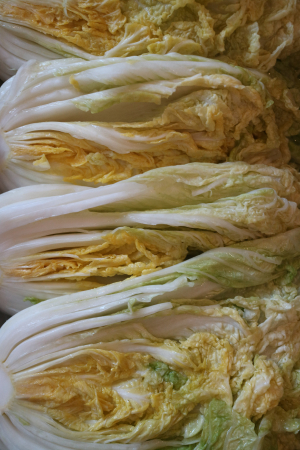 I grew up in the south of South Korea, in a town called Gwangju. My family is not big, it is just me, my sister and my parents, but we were very close to both my grandmas. My dad’s mother was a very good cook, and made the best kimchi I’ve had in my life. Every winter my mother and I would gather at my grandma’s house to make big batches of kimchi. This tradition is called Kimjang in Korea, and will often include not just family, but neighbors too.
I grew up in the south of South Korea, in a town called Gwangju. My family is not big, it is just me, my sister and my parents, but we were very close to both my grandmas. My dad’s mother was a very good cook, and made the best kimchi I’ve had in my life. Every winter my mother and I would gather at my grandma’s house to make big batches of kimchi. This tradition is called Kimjang in Korea, and will often include not just family, but neighbors too.
“One of my favourite dishes growing up was kimchi soup. It’s a classic soup in Korea that’s amazing.“
Cooking in Korea is different from region to region and very much influenced by the weather. Gwangju is a warm, calm area that produces lots of greens, herbs and vegetables. We are also closer to the sea so you will see more seafood in our dishes. In kimchi for example, people in my region will use Jeotgal, which is a type of salted and aged seafood, like clams or oysters. My grandma would tend to use Saeu-jeot, a variety of Jeotgal, made of very small shrimp that’s packed with umami.
She would add the Saeu-jeot to Korean cabbage, fresh oysters, and lots of garlic, daikon, and onions. This mix would be placed in an Onggi, a traditional Korean pot used for storing kimchi and other fermented sauces. Onggis help natural aging and fermentation, improving flavor and nutritional value, as well as regulating temperature and humidity for optimal aging and fermentation conditions.
Kimchi is made and can be kept for up to three years. Its strength in flavor develops with age, getting more and more acidic over time. The acidity in aged kimchi makes it an excellent ingredient, especially in soups and stews. Nowadays, it is more common to start eating Kimchi after it’s aged for two to three months, as keeping it longer would make it very acidic.
One of my favorite dishes growing up was Kimchi-jigae (Kimchi stew). You make it by frying pork belly and kimchi in some sesame oil, then adding Dashi stock, along with leeks, onion and chopped garlic. The soup is boiled until the meat is tender, and served with rice. It’s a classic soup in Korea that’s amazing. It’s a taste of childhood that’s hard to replicate. When I make it myself it’s just not the same, because supermarket kimchi is totally different.

What is the first recipe you remember following?
I didn’t start cooking properly until I was in my twenties. I was studying at university, and I had some spare time. My papa, knowing I had an interest in baking, bought me a dessert recipe book from Kim Young-mo which encouraged me to start baking cookies, bread, pastry and other things that I enjoyed eating.
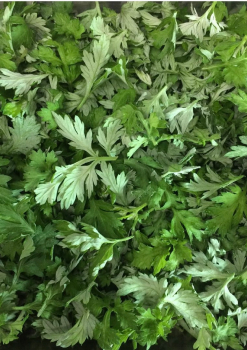
“One of my favourite rice cakes to make with my mum was Ssuk Beomuri.“
But going back earlier than that I used to love eating rice cakes, which are a very common sweet snack in Korea; one of my favorite rice cakes to make with my mum was Ssuk Beomuri. This rice cake is simply made of Ssuk (mugwort) and rice flour. It doesn’t look very appetizing but it tastes wonderful.
The Ssuk in Korea is totally different from the mugwort in the UK. In Korea mugwort is one of the most commonly used herbs. It’s at its best in Spring, but you can find it in dishes and beverages all year round. It’s one of my favorite ingredients to use because of its aroma and fresh flavor. In Europe I believe it’s mostly used in liquors and as a medicine.
Ssuk in Korea has a very fresh aroma and a beautiful color. It’s at its best when the plant is young and fresh. It is a very versatile ingredient and can be used in hot pots, rice cakes, and pancakes.
Ssuk comes into season at the very beginning of spring. So by early March you can find Ssuk everywhere in Korea; in any green areas and gardens. When I was a kid my mother would forage a full bag of Ssuk and she’d make the rice cakes, filling the house with a beautiful aroma that has become the smell of spring for me.
Ssuk is a difficult flavor to describe, but it has similar qualities to malcha, although a lot less bitter. It has a subtle earthiness, but a very fresh aroma.
Ssuk Beomuri is made very simply with rice flour, sugar and a little salt, mixed in with young, trimmed fresh Ssuk. It would be put into a steamer with some cloth underneath and a little sugar sprinkled on top. That would sit on top of boiling water for 5-15 minutes. It’s a really simple and delicious snack that you might eat just before dinner.
When I can, I bring back really good quality Ssuk powder from Korea and use it for my spring desserts.
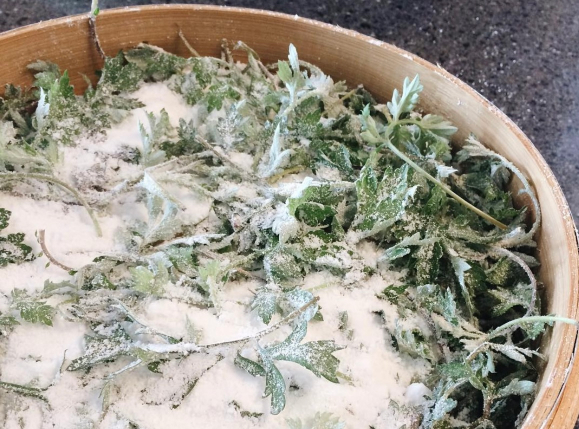
What is the recipe you’ve made the most?
I have always had a love for bread and desserts; both are very dear to me. When I began baking I became more and more fascinated by bread, especially sourdough. It’s just flour, water, and salt but with time and effort dedicated to the making of the dough, it makes the most incredible results.
Before opening Sollip, the first recipe I worked on was a sourdough. I really wanted to make our own special version, incorporating the flavor of Korea into the bread. I started experimenting with different ingredients but eventually fell upon Nurungji.
 In Korean cooking rice is the most common ingredient you’ll find. Long before rice cookers were invented, Koreans would cook their rice in Gamasot (iron pans). When the rice finished cooking there would be caramelized rice stuck to the bottom of the pan. That rice would have a delicious nutty flavor and crispy texture, and would be eaten separately; sometimes as a snack, sometimes as a porridge. We call this rice Nurungji.
In Korean cooking rice is the most common ingredient you’ll find. Long before rice cookers were invented, Koreans would cook their rice in Gamasot (iron pans). When the rice finished cooking there would be caramelized rice stuck to the bottom of the pan. That rice would have a delicious nutty flavor and crispy texture, and would be eaten separately; sometimes as a snack, sometimes as a porridge. We call this rice Nurungji.
I thought the nuttiness you get from Nurungji would work really well with the flavors of sourdough, but when developing the recipe I also discovered it added a beautiful texture to the bread.
I infuse a Nurungji made of black and brown rice in water for around 30 minutes, around 60g for 1.5kg of bread. I mix that water with spelt flour and stone ground wheat to form the dough, then add levain, salt and finally Nurungji porridge. That dough is kept in the fridge overnight, shaped in the morning then baked in the day.
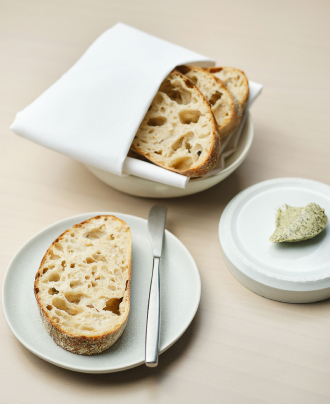
There are many variations of Nurungji, but I use the combination of brown and black because brown rice has a deep nutty flavor and the black rice has a compact texture.
One of the keys to this recipe is ensuring the rice is hydrated in the water for the right time, to get the perfect texture and flavor combination. This way you still get grains of rice running through the sourdough, giving lovely pops of texture and flavor.
This is bread we serve every day at the restaurant. Both my husband and I love this bread and we wanted to make it an important part of the meal. So it’s not served at the start, it’s served in the middle of service before the main, almost like a dish in itself. It comes to the table warm, accompanied by Dashima (kelp) butter.
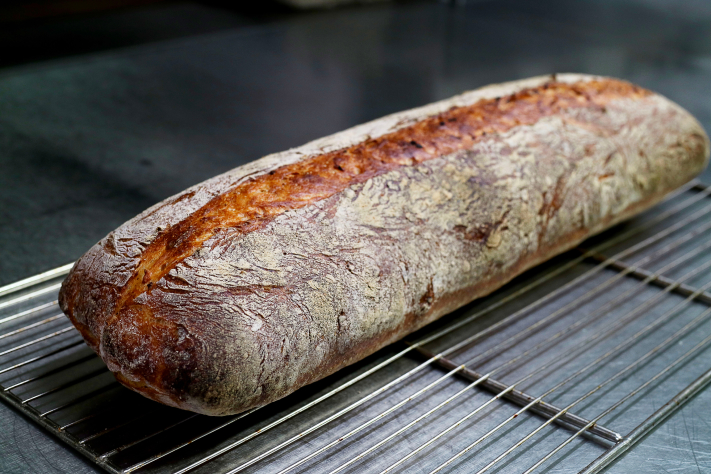
Who are the cooks or chefs whose recipes have inspired you?
The only chef I would consider my mentor is Claude Lamarche, who I worked with at The Arts Club in Mayfair. He worked with Pierre Koffmann at La Tante Claire and at the Dorchester Hotel in London. So a very classically-trained chef.
He inspired me a lot, pushing me to work hard and to my limit. But what I really loved was his respect for ingredients and how they come from nature. It was a humble and classic philosophy that helped me to understand French cooking. He taught me about discipline and chefs’ ethics – which are fundamentals to have in a kitchen.
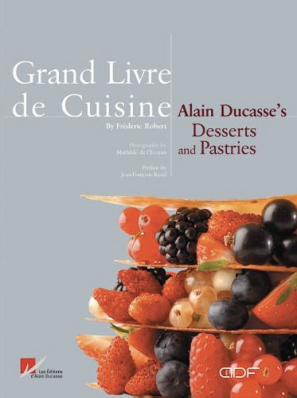
In terms of the legendary French pastry chefs, I also respect Pierre Hermé for his ever-evolving cooking style which has a big influence on the patisserie industry.
Another chef I also deeply respect is the legendary Alain Ducasse. His philosophy emphasizes and showcases the true flavors of the good quality ingredients he uses. It is a simple yet powerful mindset. One of my favorite desserts is the baba au rhum I had at Alain Ducasse’s Dorchester. It is moist and perfectly soaked with syrup, coated with apricot glaze, served with vanilla chantilly and premium rum chosen from the trolley. This dish is simple, without any unnecessary elements, but it is a well-made dessert with everything it needs.
What is the recipe you would hand down to your family?
My favorite season as a pastry chef is winter. When it comes to flavors I do really like calm, simple combinations, but in the winter, with Christmas and the holidays, I love the big celebratory flavors. Ones that are complex but harmonious. All the spices, liquor, fruits and citrus. They really work so well with the season.
There are jobs in winter each year which I always look forward to; making mulled wine, making Gugelhupf and fruit cakes. All of these are made with aged dried fruit, various spices and liquor. But the one recipe I enjoy the most is our chestnut jam.
Chestnuts are one of my favorite ingredients, especially in autumn and winter. In Korea our variety of chestnuts is a little different to the one found in Europe. It’s a little smaller, sweeter and is more tender in texture. It’s often steamed or baked and just eaten by itself, and I also love to make jam with it.
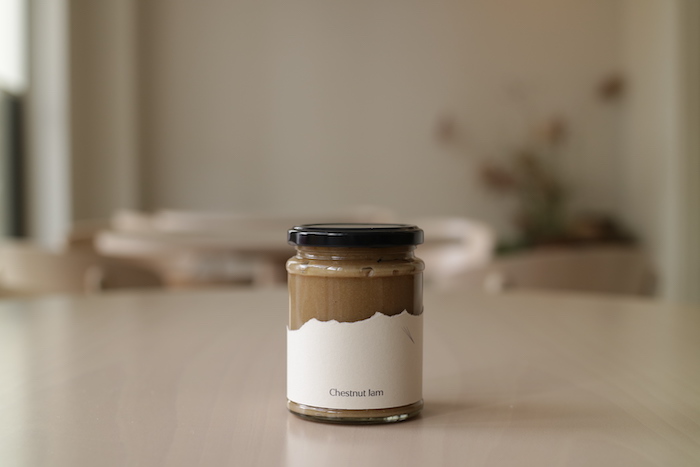 The jam is made using chestnut, chestnut flower honey, fresh milk, muscovado sugar, vanilla bean and tonka bean. It’s not overly sweet but still very decadent. I start by steaming peeled chestnuts, making sure they are very well cooked and nice and soft. Then I blend them with milk to create a smooth texture.
The jam is made using chestnut, chestnut flower honey, fresh milk, muscovado sugar, vanilla bean and tonka bean. It’s not overly sweet but still very decadent. I start by steaming peeled chestnuts, making sure they are very well cooked and nice and soft. Then I blend them with milk to create a smooth texture.
That mixture is brought to a boil, although it’s important not to put it on a high heat; you want to keep it on a medium heat to prevent burning. Once it reaches that point you reduce it down to a very low heat and add the chestnut flower honey, sugar, tonka and vanilla bean. Then you just reduce it down as slowly as possible, cooking it gently until you get a lovely jam texture. If you want a sweeter, more intense jam you can take it down further, or if you want a lighter one you can also reduce it a little less.
My favorite way to eat the jam is with a nice baguette in the morning. You can spoon it straight onto the bread and it’s like heaven in your mouth. Texture is so important to me, and chestnut jam has such a beautiful smooth texture. It’s really silky and has a deep, buttery nuttiness.
What is a dish on your current menu that represents your approach to cooking?
The black pain perdu, a dessert from our last winter menu, which we served until the beginning of March this year. Traditionally it is made with bread, though, at Sollip we do a homemade brioche which is totally black. The dessert contains Seoritae (Korean black bean), which helps give the dish its earthy flavor, color and texture. We use a lot of different beans for our rice cakes and sweets in Korea which is quite uncommon in the UK and Europe so I wanted to introduce that element.

And I’ve got the black homemade brioche with the charcoal powder. It’s made into a round shape, like a cylinder, cut into 2.5cm slices and dried for two days. After that I soak the egg mixture which is made with egg, double cream, milk, sugar and some burnt vanilla powder. I then add in a little burnt vanilla syrup. Burning vanilla gives a totally different aroma. It has a wonderful floral note that’s very surprising.
When we serve the dish we cook the pain perdu in butter and sugar à la minute, making it very hot and nice and crispy on both sides. We then place it in the oven to get it warmed in the center. Not completely cooked through, we want to keep it nice and gooey. When it comes out, we sprinkle some sugar on top and torch it until the sugars are crystallized.
That then goes into a bowl and is topped with caramelized pecan, which gives it a nice crunchiness and nutty flavor, and a quenelle of Seoritae ice cream. And finally we add a tuile made from roasted Seoritae powder on the top, and to finish, a drizzle of burnt vanilla syrup.

Adriana Cavita
LONDON, UK
"I need to balance traditional preparation with modern techniques. I can use traditional recipes as the basis of my creations, but I must also tap into my imagination and passion to create something new and unique."

Chetan Sharma
LONDON, UK
"For any young British Asian chef, or any chef interested in Indian cooking, I want them to be able to come into this restaurant and understand Indian food and Indian flavors, but also learn techniques and be open minded."

Rafael Cagali
LONDON / SAO PAULO
"Opening Da Terra was a reconnection to my own origins. I felt lost in a way. The name Da Terra means from the earth, the idea being not to forget what you come from. I like to think that I’m still exploring Brazilian cooking."

Chris Leach
LONDON, UK
"There are quite a lot of recipes I’m proud of, but there are a few that I feel are genuinely original to me. My pig skin ragu recipe is one of those. There is no meat, or rather, flesh, in the dish; it's made from just pig’s skin."




